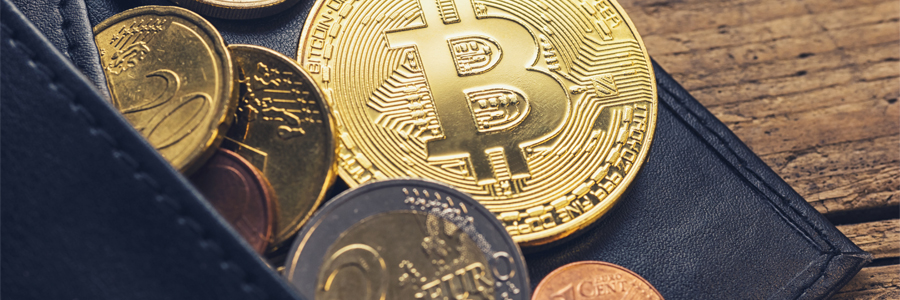THE INS & OUTS OF INVESTING

LIVE FOR TODAY… SAVE FOR TOMORROW
You get it: while you value the joy of living in the moment you are well aware that you will probably get no outside help in funding your retirement. You’ve seen how quickly wealth can be reduced. So you prefer to invest your money in a savings account, where it’s safe, insured, and gathering interest. That’s nice, as far as it goes. But sadly, it doesn’t go far enough to keep up with rising prices.

SAVING VS INVESTING
Interest rates on savings took a major hit in the 2008 crash, and they haven’t come back. Today’s banks offer a fraction of 1% interest. Inflation is expected to be at 2% through the end of this decade. That means your savings account is basically losing money. The stock market has delivered an average of 6.9% return for the last 10 years (and that average includes the 2008 plummet.) Let’s say you put $1,000 into a savings account ten years ago. You’d have $1,165 today. That’s an ROI of less than $12 a year. If you bought $1,000 in stock your investment could be worth over $12,5000 this year.

DITCH THE FEAR FACTOR
Like most millennials, you may still be a bit leery of stocks, which can vary greatly in value as the market swings up and down. True, that can be scary. But the element of risk always comes with the possibility of rewards, and stocks can be really good at delivering those. Which means they can help your nest egg expand far more dramatically than other investing instruments. And when stocks’ volatility is tempered with more stable investments, such as bonds and mutual funds, you end up with a retirement portfolio that delivers maximum returns and minimum ‘agita.’ Bottom line: you really need stocks in order to outpace inflation and ensure a comfortable retirement. Which means that keeping all your cash in savings may be the riskiest move of all.

MILLENNIALS AND THE MARKET
Here are a few facts that will ease your mind when it comes to investing:
- The market is now, always has been, and always will be, volatile. That’s its nature, and so, in a way, volatility is predictable and expected.
- Historically, the market has been up more time than it’s been down. For example, in the 50 years ending 2015 the market ‘corrected,’ losing 10% or more of its value, 27 times. And it recovered all its value every single time.
- The best antidote to market volatility is time. And you have all you need! Investing young gives you the power to ride out the market dips, hold onto your stocks for the long haul, and potentially come out a winner.

HOW DO YOU KNOW YOU’RE READY?
Rule of thumb: your aim should be to start investing after you’ve built your firm financial foundation. That’s why experts suggest you take care of these money matters first:
- Pay off your high-interest debt. Say you have a $2000 credit card balance, at 17% interest. If you invested that $2000 you’d need to earn 17% return just to break even. That’s more than double the 10-year average ROI, so it’s highly unlikely to happen. Ergo, getting that expensive debt off your back ASAP is the smartest way to spend your money right now.
- Fully fund your emergency account. You need 3-6 months of living expenses to cover the ‘what-ifs.’ And keep that account separate.
- Feed your 401(k). It’s all about a comfortable retirement. So max out on your IRA and 401(k)s, especially if you get employer contributions (aka free money.)

ACE YOUR ASSET CLASSES
Here’s a quick thumbnail of investing basics.
When you buy stock, you are actually buying a tiny piece of ownership of that company, aka equity shares. How much your investment grows depends on the success of the company. If it does well, the value of your shares of stock will grow.
Stocks offer two ways to earn money:
Dividends – when a company is thriving, they may share some of their profits with shareholders by paying them a dividend. You can take the cash or reinvest your dividend in more shares of company stock.
Capital gains – when the value of your stock becomes greater than the price you paid for it, you can sell your shares and make a profit.
The stock market, as you know, cycles from strength to weakness and back, taking the value of your investments along for the ride. And as the stock market goes down, the value of other types of investments might rise. That’s why experts extol the wisdom of diversifying your portfolio (aka asset allocation.) And that’s where these next categories come in.
Unlike owning tiny shares of a company, a bond is a loan that you make to the government, a corporation, municipality, or other entity. A bond’s interest rate is set at its issue, and does not change. In exchange for your loan, you receive regular interest payments for a specific length of time, plus repayment of your principal when the bond matures. Although considered more secure than stock, bonds do come with risks. You can lose money if you sell any type of bond before it matures. Also, bonds are rated as to their risk level, from AAA (high grade) to BB and below (speculative or junk bonds) which could end in default.
Here are some bond scenarios:
- Pay par – a new bond is issued and you pay full face value (par), because it offers you a very competitive interest rate over its term (eg, 10, 20 or 30 years.) So you collect the interest and at maturity you are repaid your original investment.
- Pay below par – interest rates have risen since the bond was first issued, so it’s not as tempting for investors. To compensate for the reduced interest income, you are offered a lower-than-face-value purchase price. In other words, the bond goes ‘on sale.’ At maturity, you receive the full face value. Plus you get whatever interest income was earned along the way.
- Pay premium – interest rates go in reverse: the bond’s issue rate is higher than what is currently available. So you are willing to pay higher-than-face-value in order to get that higher interest. You’ll only get the face value when the bond matures, but theoretically the interest you enjoyed along the way will more than make up for it, making it a good investment.
US Treasury Securities are considered the safest bonds. Some of the many other types include mortgage-backed and international.
Ever hear the expression ‘don’t put all your eggs in one basket?’ A mutual fund is the best way to avoid that. It is a collection of stocks, bonds and other securities, which are bought and sold by a fund manager. When you invest, you are buying a small share of the entire fund, rather than owning a piece of every security within that fund. Mutual funds can hold hundreds or more stocks or bonds, so they are highly diversified investments. This helps reduce market risk, because if some of the stocks go down, others in the fund will hopefully go up, compensating for any loss. So how do you know how much a share is worth? By calculating the net asset value (NAV) of all the different securities in the fund divided by the number of shares. Mutual fund shares are traded constantly throughout the day, but their prices are adjusted at the end of each business day.
Here are the advantages of mutual funds:
- Diversification – with a small investment, you can have access to tons of different securities.
- Simplicity – it’s an easy way to acquire a whole portfolio of different stocks and bonds, with basically no knowledge needed.
- Effortless – no need to follow the market, analyze trends or make buy/sell decisions. Your fund’s professional manager does it all for you.
- Access – many funds focus on specific areas of the market, such as tech, pharma, social media, etc. These ‘sector funds’ enable you to pick and choose the asset types you prefer to invest in.
Rather than having a manager buying and selling individual stocks and bonds, this type of mutual fund has a portfolio that matches a particular market index, such as the S & P 500. In other words, Standard & Poor selected 500 stocks that represent the overall market. This ‘index’ is watched to reflect the condition of the market. So an S & P index fund would duplicate those same 500 stocks. A Dow Jones Industrial Average fund would consist of the same 30 large US stocks that are included in that portfolio. Index funds enable investors to access the stock market’s potential without having to choose individual stocks. And they don’t require the ‘hands-on’ management of mutual funds, so they have lower fees.
ETFs have become the investment of choice for millennials. This is a type of mutual fund, consisting of a ‘basket’ of hundreds or even thousands of stocks or bonds. But it is traded like an individual stock, and its value can rise and fall throughout the day. Most ETFs are index funds, tracking the companies of a particular index. But there are also ETFs that use non-traditional indexes, as well as ones that reflect specific market sectors. ETFs aim to track an index, not outperform it. This ‘passive management’ requires only minor activity. And rather than depending on a savvy manager to grow your investment, an ETF enables you to grow via the power of the market itself. With lower costs, tax advantages, and low investment requirements, it’s no wonder millennials accounted for more than half of all ETF investors last year.

A BIT ABOUT cryptocurrency
Hard to believe that a generation that’s leery of the stock market has developed a taste for investing in such an unpredictable and volatile commodity. (Not to mention that most of us aren’t sure exactly what it is.) So let’s start with a bitcoin breakdown: in broad terms, bitcoin is a peer-to-peer monetary system that eliminates the banking system. Bitcoins have value just like regular money, but that value fluctuates throughout the day, based on supply and demand. Like actual currency, a bitcoin can be broken down into smaller pieces of currency (like changing a dollar into nickels and dimes.) But unlike dollars, nickels and dimes, which you can hold in your hand, bitcoins are digital (like the paycheck that’s direct deposited into your checking account.) There is a finite amount of bitcoin available in the whole world, and it is usable globally, and worth the same everywhere. And every bitcoin transaction takes place via computer and the cloud. As people collect and spend this crytocurrency, it is tracked on a massive public ledger called a blockchain. You can buy bitcoins, or earn them by using your computer smarts to verify and support the transactional processes and other mathematical requirements of the virtual currency system. This is called mining. The bitcoins you buy or earn are delivered to your computer via your secret password or ‘key.’ Forget your key? You lose all your bitcoins.
Cryptocurrency was developed in 2009 as a means of making online payments. Expedia, Overstock, and Microsoft are among the companies accepting bitcoin. But a large number of people have started investing in bitcoin, hoping to net gains as their value rises. In one year alone, it increased in value more than 20 times. The next year its value plummeted by 80%. Despite those monumental swings, millennial interest remains strong, and it is becoming more mainstream, with over 100 hedge funds now specializing in cryptocurrency.
Unfortunately, digital currencies have been frequent targets for cybertheft. If you’re thinking of investing, here are some other facts to ponder first:
- It is not backed by the government or central bank, such as silver or gold. Instead, it is only as valuable (or worthless) as people think it is.
- It isn’t traded on the stock market, and can’t be bought through a stockbroker.
- You need to create a special account, or ‘wallet,’ for bitcoins, and though you can then link it to a traditional banking account, it is much less liquid than regular money.
- Volatility is far greater than other forms of currency, opening the door to rewards but also to more potential risk than traditional investments.
- The virtual currency environment is susceptible to higher levels of theft and fraud. Criminals feast on this unregulated market, and hacked investors have no protection or recourse.
Nobody can tell how the bitcoin market will evolve, and where its price and value may swing. However, experts agree that blockchain technology will endure, and may be instrumental in transforming future financial transaction processes.

INVESTING THAT APP-EALS TO YOU
It’s no surprise that you and your tech-loving generation is redefining how to invest. Your endless supply of social media tools enables you to learn anything you want to know about the market. With a click or two you can get advice from peers, find product-picking tips, follow stocks, and even purchase shares. One popular social investing platform, Tip’d Off, even enables inexperienced investors to duplicate the moves of people with proven stock market success.
No money? No problem! There are a slew of apps designed for millennials with not a lot of cash to invest. For instance, Acorns will follow your debit and credit card purchases, automatically round up your total to the nearest dollar, and set aside that extra change to invest. Once you hit the $5 level, it invests your money into the portfolio you’ve selected. The Stash app enables users to invest in fractional shares of ‘themed’ ETFs such as clean energy companies, or pieces of Amazon, Facebook, and 48 other big-name companies, all in $5 increments. Got the bitcoin bug? Consider Robinhood, one of the only brokerages to offer crypo trading. Voleo takes a team approach, enabling groups of 3 to 100 to combine resources and create a communal $500 portfolio. Finally, put your money where your heart is, and invest in socially responsible stock portfolios such as zero waste or renewable energy, with the Swell platform.

SO WHAT’S YOUR INVESTING TAKEAWAY?
Like it or not, if you plan to live somewhere and eat everyday when you’re 80, you need to start investing. Here are some rules to remember as you get going:
- Don’t wait – the market offers far greater potential ROI than other options can. And through the magic of compound interest, your balance doesn’t just grow, it grows at an accelerated rate. Need proof? If you invest $1000 a year for 20 years in the market, assuming a 7% ROI, you’d end up with over $47,700. More than half your balance is ‘free’ money thanks to compounding.
- Don’t let stock-stupidity stop you – there’s no need to pick your own stocks, or to develop strategies. Index and mutual funds do all the choosing for you.
- Don’t think you can’t afford it – buy marginal shares on your cell phone for $5; sell stuff online; start a side hustle. There are no excuses – only missed opportunities.
- Don’t invest money you may need next year – historically, the market outperforms other investments over time. That means leaving your money invested for a minimum of 5 years in order to enjoy those long-term gains. So if you’re trying to accrue funds for a wedding reception, down payment or new car, consider a short-term instrument like a money market account or CD instead.
- Don’t be ruled by fear –stocks are a great choice for young people. Yes, they can be volatile. And guaranteed the market will slip and slide. But you won’t lose a single cent if you don’t sell. So resist the impulse to react to bad markets, wait out the bumps, and your bravery will be financially rewarded.
